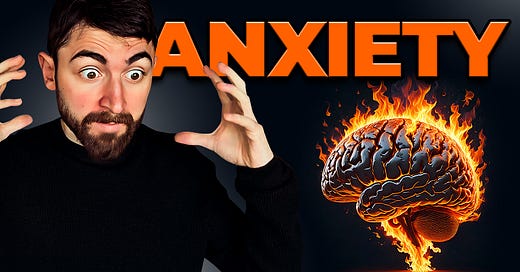Inflammation Causes Anxiety: Root Cause and Cure
Behavioral states and emotions — including anxiety — can be the consequence of a metabolic state. New data show how inflammation can act directly on the brain to promote anxiety.
*This weekend is a twofer! Why? Because I’m pumped! All the engagement and curiosity around yesterday’s Sugar Diet letter, and other recent popular letters on the Heart-Brain Health Axis and Lp(a), rocketed us to #1 in the “Rising Science” Category on the entire Substack App. That’s big! These moments tend to be fleeting. Still, it’s a wonderful graduation gift. And it’s all thanks to you!
Now, today’s letter …
What causes anxiety?
Obviously, the answer is many things.
But an under-appreciated truth is that behavioral states and emotions — including anxiety — can be the consequence of a metabolic state.
New data show how inflammation can act directly on the brain to promote anxiety.
This one is somewhat personal for me. I spent years suffering from an inflammatory disease — and it was catastrophic for my mental health. It caused anxiety.
Beyond my own experience, doctors have long observed a curious phenomenon: after certain infections or flares of an autoimmune disease, some people experience mood swings or anxiety — even after the infection or flare resolves.
These new data shine a light on both my experience and that phenomenon. They argue that inflammation doesn’t just make you feel physically sick — it can directly act on the brain to cause anxiety. Now, let me show you.
The Villain: IL-17
The story of this study begins with its antagonist — its villain — an inflammatory molecule called IL-17. Now, to be clear, inflammatory molecules like IL-17 aren’t simply “bad.” I’m simplifying here. Inflammation is part of the immune response and has its functions.
But in this story, IL-17 is the culprit. IL-17 levels are increased in inflammatory disorders like psoriasis, inflammatory bowel disease (ulcerative colitis and Crohn’s disease), rheumatoid arthritis, and ankylosing spondylitis.
It’s certainly relevant to humans. But to prove a causal connection between IL-17 and anxiety, researchers turned to animal models.
The Experiment
Researchers treated mice with a chemical that increased IL-17 levels. This made the mice more anxious on three different validated behavioral tests as compared to control animals.
Nuance Note: The nature of the behavioral tests it’s essential for you to know. Feel free to skip this paragraph. But for those interested they are called “Elevated Plus Maze,” “Light-Dark Test,” and “Open Field Test.”
Elevated Plus Maze (EPM) works as follows: Mice are placed on a plus-shaped platform elevated above the ground with two open arms and two closed arms; anxious mice spend more time in the closed arms, avoiding the exposed open arms.
Light-Dark Test (LDT) works as follows: Mice are placed in a chamber divided into a brightly lit area and a dark enclosed area; anxious mice prefer to stay in the dark compartment, avoiding the exposed light area.
Open Field Test (OFT) works as follows: Mice are placed in a large open arena; anxious mice spend more time near the walls (thigmotaxis) and avoid the exposed center of the field.
Next, to connect the dots, the researchers looked for IL-17 receptors in the brain. Indeed, they found that IL-17 receptors were concentrated in the anxiety center of the brain, the basolateral amygdala.
*Above is shown Figure 2B from the paper. The red/pink color represents expression of the receptor IL-17 (specifically the IL-17RA form). You should note, a strong concentration of IL-17RA in the section “BLAa,” which stands for basolateral amygdala anterior.
And they found that directly administering IL-17 into the brain induced anxiety.
Furthermore, chemically turning “on” or “off” the neurons in the basolateral amygdala that harbored IL-17 receptors turned anxiety “on” or “off” in the animals, respectively.
This strongly suggests that neurons in the basolateral amygdala can cause anxiety — and that increasing levels of the inflammatory signaling molecule, IL-17, activates these neurons to promote anxiety.
The rest available to paid subscribers of this letter will review:
Mechanism: How does IL-17 effect the brain?
The Chemical Counterbalance to IL-17, IL-10
Takeaways(s) and Why This Matters to You
Keep reading with a 7-day free trial
Subscribe to StayCurious Metabolism to keep reading this post and get 7 days of free access to the full post archives.








